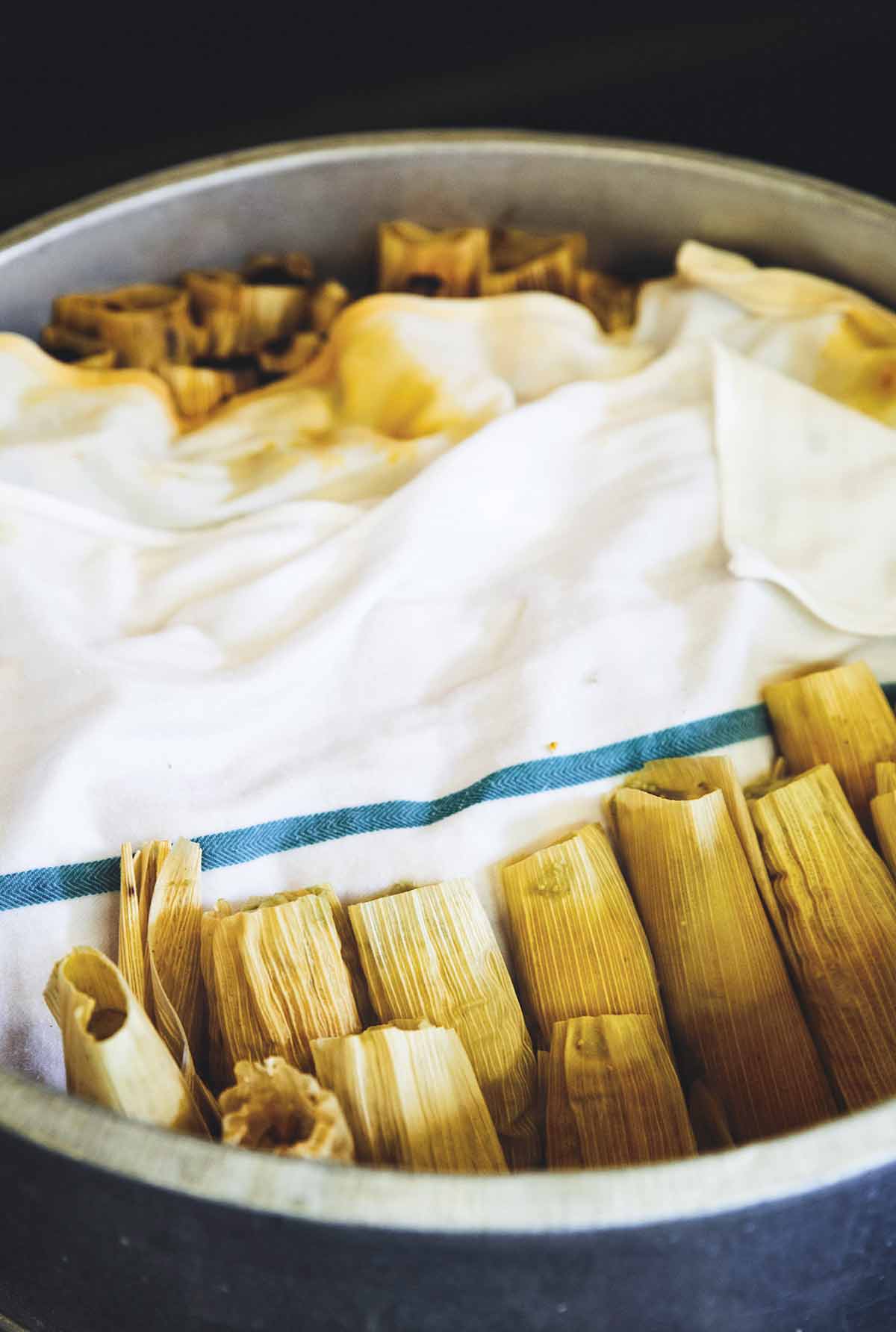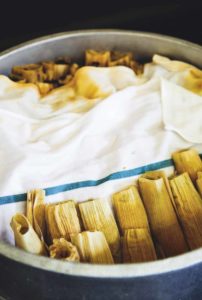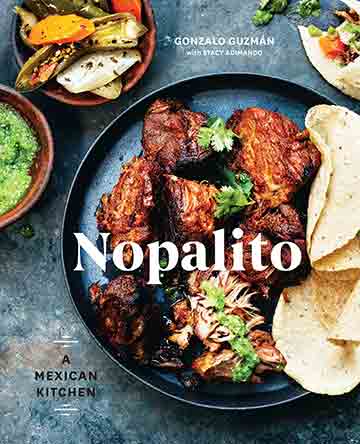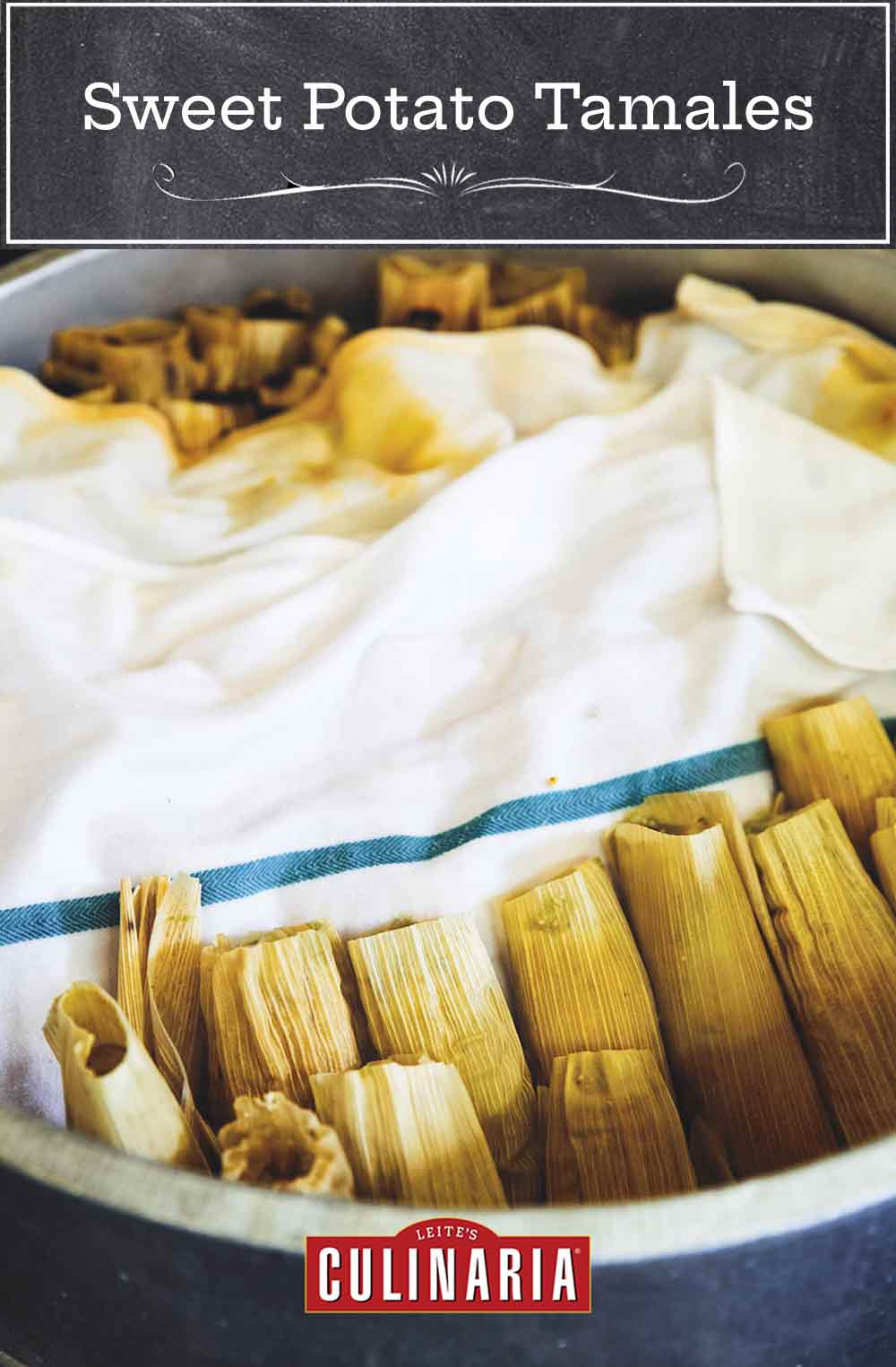
In Mexico, the tamal—a collection of corn masa and sometimes other fillings wrapped in a corn husk, banana leaf, or other package—is just like a taco or any antojito in that the filling can change with the season, region, or occasion. Sweet potato is our seasonal choice for fall at the restaurant, and it pairs really well with a spicy-sweet mole. Be sure to prepare the mole before you get started on the tamales. Achieving the balance of flavors in a mole is a bit like blending paint colors, which is why the best versions have many ingredients. Here, a mole amarillo (“yellow mole”) gets its color from a combination of dark and red chiles, bright red fresh tomatoes, and green tomatillos. This recipe makes extra so that the next few times you crave mole to use atop chicken, fish, pork, veggies, or enchiladas, you will have it at your fingertips—no spice blending required.–Gonzalo Guzman & Stacy Adimando
*What’s the difference between masa and masa harina?
Masa harina is corn flour, while masa is the dough that you get when you mix masa harina with water. The dough is used for tortillas and tamales, just be aware that masa for tortillas is more finely ground than the masa that’s sold for tamales. And don’t pick up corn flour by mistake—it’s definitely not the same thing. When making these tamales, you need masa. Trust us.
Want to save this?

Sweet Potato Tamales
Ingredients
For the mole amarillo
- 5 medium dried guajillo chiles, stemmed and seeded
- 2 medium dried ancho chiles, stemmed and seeded
- 3 medium dried morita chiles, stemmed
- Boiling water
- 5 whole cloves
- 4 bay leaves
- 1 1/2 teaspoons cumin seeds
- 1 1/2 teaspoons ground dried pimiento (paprika)
- 1 1/2 teaspoons ground allspice
- 1 cup mild vegetable oil
- 1/2 medium white onion, chopped
- 2 cloves garlic, chopped
- 1/2 jalapeño, stemmed
- Kosher salt
- 1 cup diced canned tomatoes and their juices
- 10 medium (1 lb) tomatillos, husked and rinsed
- 1/2 cup raw unsalted pepitas (pumpkin seeds)
- 1/2 cup unsalted peanuts
- 1/2 cup store-bought or homemade masa* or masa prepared from store-bought masa harina, according to package directions
For the masa mixture
- 2 medium (1 lb) whole sweet potatoes, peeled, plus 6 cups 1/2-inch (12-mm) peeled and diced sweet potatoes (700 g)
- Olive oil
- 7 cups store-bought or homemade masa* or masa* prepared from store-bought masa harina according to package directions
- 6 sticks (24 oz) unsalted butter, softened
- 1 tablespoon kosher salt, plus more as needed
- 1 teaspoon baking powder
For the sweet potato filling
- 1 tablespoon olive oil
- 1/2 medium white onion, chopped
- 1 jalapeño, thinly sliced
- 1 clove garlic, chopped
- 2 cups mole amarillo
- Kosher salt
To assemble
- 20 large corn husks or 40 small ones
Instructions
Make the mole amarillo
- Preheat the oven to 350°F (180°C).
- Place all of the chiles on a rimmed baking sheet and roast for 5 minutes. Remove the chiles but don’t turn off the oven. Put the chiles in a medium heatproof bowl, add enough boiling water to cover, and let sit until softened, about 20 minutes.
- On the same baking sheet, spread out the cloves, bay leaves, cumin, pimiento, and allspice. Roast, stirring the spices around halfway through baking, until toasted and aromatic, 7 to 10 minutes.
- In a medium pot over medium-high heat, warm 1/4 cup oil. Add the onion, garlic, and jalapeño, lower the heat to medium, season with salt, and cook, stirring occasionally, until the vegetables are very softened and the onions are translucent, 10 to 15 minutes.
- Add the tomatoes and their juices and bring to a simmer. Cook, stirring occasionally, until thick and jammy, 25 to 30 minutes.
- Dump the tomato-onion mixture into a blender and add the spices, tomatillos, pepitas, peanuts, drained reconstituted chiles (reserve the soaking water), and a generous pinch of salt. Process, adding some of the soaking water a little at a time, until the mixture is smooth and thick.
- In a large pot over medium-high heat, warm the remaining 3/4 cup oil until hot. Turn off the heat and add the tomato-onion mixture quickly and all at once (be careful as the mixture will splatter). Bring the mixture to a boil. Reduce to a gentle simmer and let cook, uncovered, stirring occasionally, until thick, about 2 hours. Taste and add more salt if needed.
- In a clean blender, working in batches if needed, combine the masa with about 1 cup water and blend until very smooth.
- Pour the contents of the blender slowly into the tomato mixture and let cook for 30 minutes more. Taste and add more salt as needed. The mole can be fully cooled and stored at this point for up to 5 days.
☞ TESTER TIP: This recipe makes more mole than you’ll need for the tamales, but that’s not a problem. Spoon any leftover mole over grilled or roasted meats or tuck it inside a burrito.
Make the masa mixture
- Preheat the oven to 350°F (180°C). Line a rimmed baking sheet with foil or parchment paper.
- Rub the whole sweet potatoes with olive oil and wrap them, side by side, in a single sheet of foil and place on the baking sheet. Bake until extremely soft, 75 to 90 minutes. About halfway through baking, place the diced sweet potatoes on the baking sheet and roast until al dente, 20 to 40 minutes.
- Once cooled, peel and quarter the whole sweet potatoes. Add them to a food processor, and puree until smooth, about 2 minutes. Reserve the roasted diced sweet potatoes for the filling.
- To the bowl of a stand mixer fitted with the paddle attachment, add 1 cup of the puree. Add half each of the masa, butter, salt, and baking powder, and beat until well combined. (Alternatively, you can mix the ingredients by hand, but the stand mixer creates an airier result.)
- Move this mixture to a larger bowl and then repeat the mixer processing with another 1 cup of the potato puree and the remaining masa, butter, salt, and baking powder. Combine with the first batch, then taste and adjust the seasoning as needed (it should taste well-seasoned). Reserve any remaining potato purée for another use.
Make the sweet potato filling
- In a medium skillet over medium-high heat, warm 1 tablespoon olive oil. Add the onion, jalapeño, and garlic, and season with salt. Cook, stirring occasionally and reducing the heat if necessary to avoid browning the onions, until the onions are translucent, 5 to 10 minutes.
- In a large bowl, combine the onion mixture, the roasted diced potatoes, and 2 cups of the mole amarillo. Taste and add more salt as needed.
Assemble the tamales
- Soak the corn husks in a large bowl or a sink filled with very hot water until softened, about 20 minutes. Remove from the water (no need to dry them off). Working with one at a time, place a husk on a clean work surface with the curved side facing up and the narrower end facing you. (Some husks will be smaller than others—if necessary, use a couple of small husks together, overlapping their long edges slightly.)
- Using a spoon or your hands, place a heaping 1/4 cup of masa over the center of each corn husk, leaving a 1 1/2-inch (4-cm) border clear along the wide, flat end of the husks. Spread the masa out to form a round that’s about 3 inches (8 cm) across. Add about 3 tablespoons of the chunky sweet potato filling in a line down the center of the masa and spoon some of the sauce over the top. Fold the long edges of the corn husk over the filling to cover, first one side and then the other. Finally, fold the pointy end of the husk over to form a packet (the opposite end of the tamal should remain open). At this point, you can cover and refrigerate the tamales for up to 2 days or freeze the them. Add an extra 15 minutes of steaming time if starting with frozen ones.
- Prepare a bamboo or metal steamer over high heat.
- When steaming, put the tamales in the steamer, piling them as needed to fit, either horizontally or with their open ends facing up. Steam until the masa has firmed, adding boiling water as necessary, 60 to 120 minutes. (To test, open the husk: a toothpick inserted into the masa should come out mostly clean.)
- Let the tamales cool slightly prior to devouring.

Explore More with AI
Nutrition
Nutrition information is automatically calculated, so should only be used as an approximation.
Recipe Testers’ Reviews
These sweet potato tamales are rich, earthy, and, yes, subtly sweet. While it might be intimidating to make tamales from scratch, once you have all the elements ready, it’s not a difficult task. All you need is time. That first little corn husk-wrapped package will be your golden gift at the end of the day, and it is all worth the effort, I promise.
This recipe produces the most tender and delicious tamales I’ve ever had! The masa for the tamale is soft, buttery, and beautiful in color from the addition of mashed sweet potato. The filling has just the right amount of spice from the mole and a bit of jalapeño.
The mole amarillo is a luscious combination of chiles, tomatillos, and onions with warm spices that cook into a deeply flavored sauce. The sauce alone is worth making if you don’t want to tackle the tamales. Spoon it over grilled or roasted meats, chicken, seafood, or use as seasoning in burrito fillings and freeze what’s leftover.
Finding affordable prices for the chiles was my biggest challenge in sourcing the ingredients. All the other ingredients were available at the local supermarket. The chiles are available online but I found the best prices at a local Latin American grocery store. That store also had great prices on tomatillos, dried corn husks, and sweet potatoes.
This recipe is quite extensive and makes a lot of tamales. I made just 1/3 of the recipe for the tamales, but the full-size recipe of the mole. My suggestion is to divide preparation into 3 parts and prepare over 2 or 3 days. Day 1: Make the mole and refrigerate. Day 2: Prepare the masa and the sweet potato filling and refrigerate. Day 3: This is the fun day. Remove the masa from the refrigerator and bring it to room temperature while you soak the corn husks. Get your friends and family together to fill and wrap the tamales. Start steaming and eating!
This is the definition of a “weekend project.” After spending hours making these tamales over the course of 2 days (mole on day 1, tamales on day 2), on one hand I was hoping they would just be OK and I wouldn’t want to dedicate my weekend to making them again, but on the other hand, I really wanted the time spent to be worth it. The latter turned out to be true—they were delicious, and the hours spent in the kitchen were soon forgotten as I dug into the rich, warm, flavorful little packets of comfort.
As both a mole and tamale novice, this was quite the undertaking for me, but I was empowered by the excellent selection of ingredients at my local Mexican market to take on the challenge. The recipe is long, but I believe it is also forgiving. It’s OK if your mole is a little chunky or your masa mixture is a little lumpy. In the end, it all melds together in its little pouch and it will turn out fine.
That being said, I would highly recommend taking your time and making these over 2 days or even 3. Make the mole and filling components in advance, then on the day you plan to eat them, take a couple hours to assemble everything. The best part is now I also have a freezer full of leftovers, so I don’t have to spend days making these for a long time (until I run out…which might be soon!)
I used 4 cups ( 525g) masa harina (Bob’s Red Mill) and 4 cups of boiling water. I started with 3 cups of water, but the dough was too dry. Luckily, it’s all corn and you don’t have to worry about overmixing and forming gluten as with a wheat dough, so just keep adding water if you need to. Mine was pliable and soft but kept its shape like Play-Doh. I’ve learned from making pupusas: make sure to cover the dough with a towel and let it sit for about 20 minutes so the water can soak into the masa harina.
It’s important to taste and salt all the components just as the recipe states. In the end, mine needed a little sprinkling of salt at the table.
I really liked the flavor of this mole. I made a different mole rojo recipe a few weeks ago and it was much darker and intense in flavor. While complex in its own right, I liked the slightly lighter flavor of this mole amarillo and think others might find it more approachable if they were lukewarm on other moles. I’m looking forward to using the leftovers, maybe for chicken tamales.












